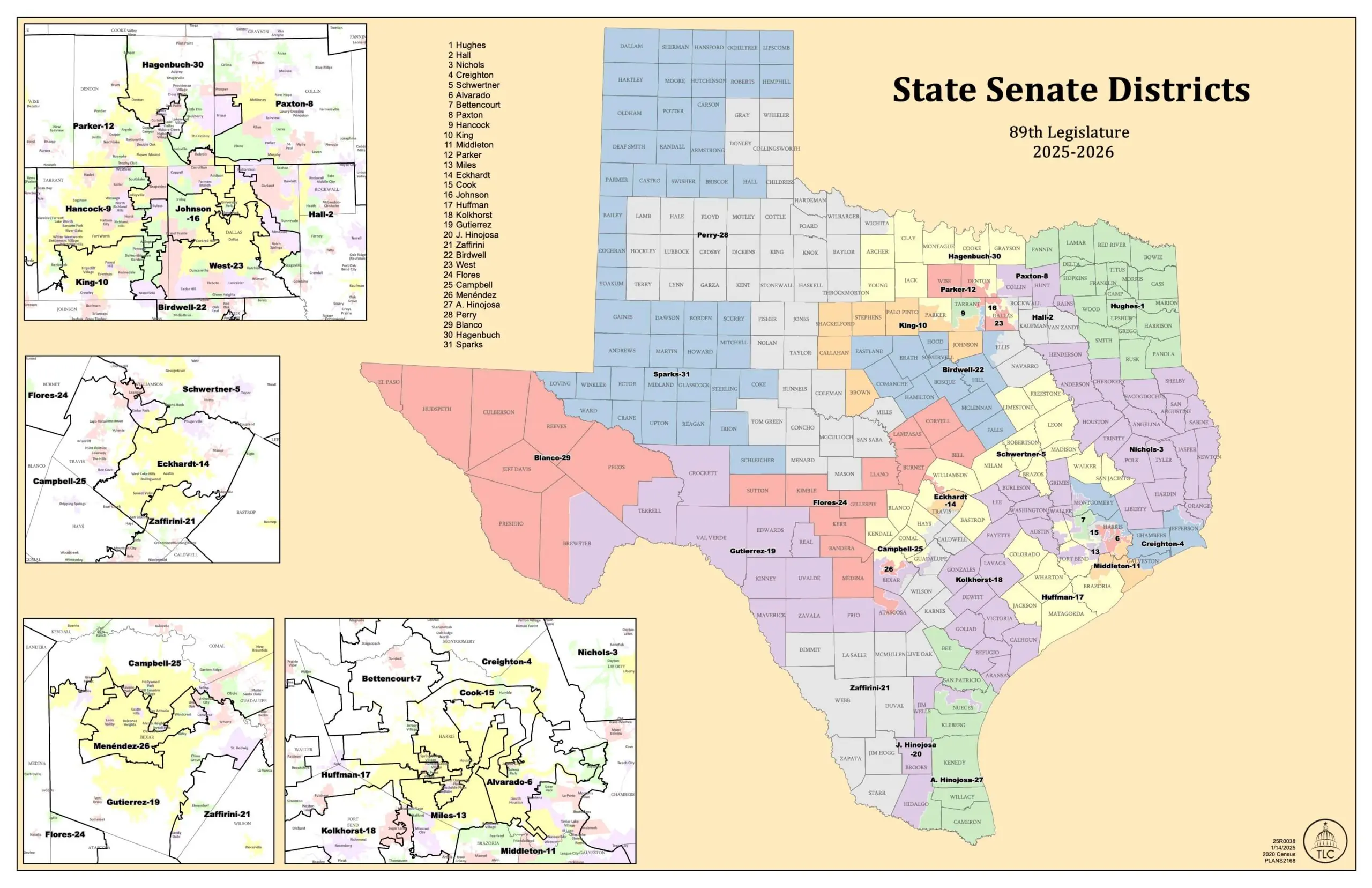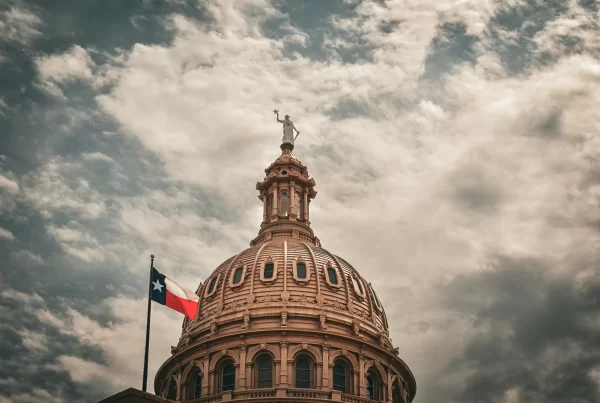The Texas Senate is one of two parts, or chambers, of the Texas State Legislature. Together with the Texas House of Representatives, it makes laws and approves the state budget. Established in 1846 as the successor to the Republic of Texas Senate, the Senate plays a crucial role in shaping policies that affect millions of Texans.
The Senate consists of 31 elected senators plus the lieutenant governor, who presides over the chamber. Each senator represents a district with a population of approximately 800,000.
The senate meets in the east wing of the Texas State Capitol in Austin.
“There are always fashionable proposals afoot that catch the fancy, but that would, for all their appeal, trample roughshod over the interests of some citizens. The Senate exists to temper these projects. The Senate, to a greater extent than the House of Representatives, can take the long view. Its members are more insulated from the turning electoral tides. They represent a broader-based constituency.”
Bill Hobby, Lieutenant Governor from 1973 to 1991.
Together with the Texas House, the Texas Senate has the following functions and powers:
- Enacting and amending state laws
- Approving the state budget
- Raising and lowering taxes
- Confirming gubernatorial appointments
- Redrawing congressional and legislative maps every 10 years (redistricting)
- Establishing the boundaries of district courts and appellate courts
- Voting to uphold or override gubernatorial vetoes.
Additionally, the senate is responsible for holding a trial for officials impeached by the Texas House. At the conclusion of such a trial, a vote of two-thirds of the senators is required to remove an official from office.
Elections for the Texas Senate take place every two years in even-numbered years (such as 2022, 2024, 2026). Generally, each Texas state senator serves a four-year term. However, following decennial redistricting, half of Texas senators serve only a two-year term.
This is determined by a lottery system to ensure staggered elections continue. This system maintains balance in the Texas Senate after each U.S. Census.
In order to qualify to serve as a state senator, a person must be 26 years old, a citizen of the United States, a five-year resident of Texas, and a minimum one-year resident of the senate district in which he or she is running.
The political composition of the Texas Senate has remained Republican-controlled since 1997, shaping key legislative priorities such as tax policy, education reform, and border security.
🟦 Democrats: 11 seats
🟥 Republicans: 20 seats
⚖️ Lieutenant Governor: 1 (only votes in case of a tie)
The Texas Senate consists of 31 senators, plus the lieutenant governor, who serves as the presiding officer. While this technically brings the total to 32 members, the lieutenant governor only votes in the event of a tie—a rare occurrence since the number of senators is odd.
A simple majority (16 votes) is required to pass most legislation, while certain measures—such as constitutional amendments and procedural rule changes—require a supermajority vote.
- Gender Diversity: 8 women, 23 men
- Ethnic Diversity: 21 White, 8 Hispanic, 2 Black
| District | Senator | Party | Residence | First elected | Next election |
|---|---|---|---|---|---|
| 1 | Bryan Hughes | Rep | Mineola | 2016 | 2026 |
| 2 | Bob Hall | Rep | Edgewood | 2014 | 2026 |
| 3 | Robert Nichols | Rep | Jacksonville | 2006 | 2026 |
| 4 | Brandon Creighton | Rep | Conroe | 2014† | 2026 |
| 5 | Charles Schwertner | Rep | Georgetown | 2012 | 2026 |
| 6 | Carol Alvarado | Dem | Houston | 2018† | 2028 |
| 7 | Paul Bettencourt | Rep | Houston | 2014 | 2028 |
| 8 | Angela Paxton | Rep | McKinney | 2018 | 2028 |
| 9 | Kelly Hancock | Rep | Fort Worth | 2012 | 2026 |
| 10 | Phil King | Rep | Weatherford | 2022 | 2028 |
| 11 | Mayes Middleton | Rep | Friendswood | 2022 | 2026 |
| 12 | Tan Parker | Rep | Flower Mound | 2022 | 2028 |
| 13 | Borris Miles | Dem | Houston | 2016 | 2026 |
| 14 | Sarah Eckhardt | Dem | Austin | 2020† | 2028 |
| 15 | Molly Cook | Dem | Houston | 2024† | 2028 |
| 16 | Nathan Johnson | Dem | Dallas | 2018 | 2028 |
| 17 | Joan Huffman | Rep | Houston | 2008† | 2028 |
| 18 | Lois Kolkhorst | Rep | Brenham | 2014† | 2026 |
| 19 | Roland Gutierrez | Dem | San Antonio | 2020 | 2026 |
| 20 | Juan Hinojosa | Dem | McAllen | 2002 | 2028 |
| 21 | Judith Zaffirini | Dem | Laredo | 1986 | 2026 |
| 22 | Brian Birdwell | Rep | Granbury | 2010† | 2026 |
| 23 | Royce West | Dem | Dallas | 1992 | 2028 |
| 24 | Pete Flores | Rep | Pleasanton | 2022 | 2026 |
| 25 | Donna Campbell | Rep | New Braunfels | 2012 | 2028 |
| 26 | Jose Menendez | Dem | San Antonio | 2015† | 2026 |
| 27 | Adam Hinojosa | Rep | Corpus Christi | 2024 | 2028 |
| 28 | Charles Perry | Rep | Lubbock | 2014† | 2026 |
| 29 | Cesar Blanco | Dem | El Paso | 2020 | 2028 |
| 30 | Drew Springer | Rep | Muenster | 2020† | 2028 |
| 31 | Kevin Sparks | Rep | Midland | 2022 | 2026 |
The Lieutenant Governor of Texas serves as the presiding officer of the Texas Senate and wields significant powerover legislative affairs. Unlike some states where the lieutenant governor has a ceremonial role, in Texas, the lieutenant governor:
- Controls the legislative agenda
- Appoints committee chairs and members
- Casts the tie-breaking vote in the Senate
- Interprets and enforces parliamentary rules
The current Lieutenant Governor of Texas is Dan Patrick (Republican).
The senate has one other constitutional officer, the President Pro Tempore, who is elected at the beginning of each legislative session. The role of the President Pro Tempore is to perform the duties of the lieutenant governor in case of any absence or disability. Presidents pro tempore are usually the most senior members of the Senate.
Other powerful positions include the chairs of the Finance and State Affairs committees. Generally, each member of the majority party (the Republicans) chairs at least one committee, while Democrats typically are excluded from committee leadership, except in the case of a few vice chair positions, which are held by senior Democrats.
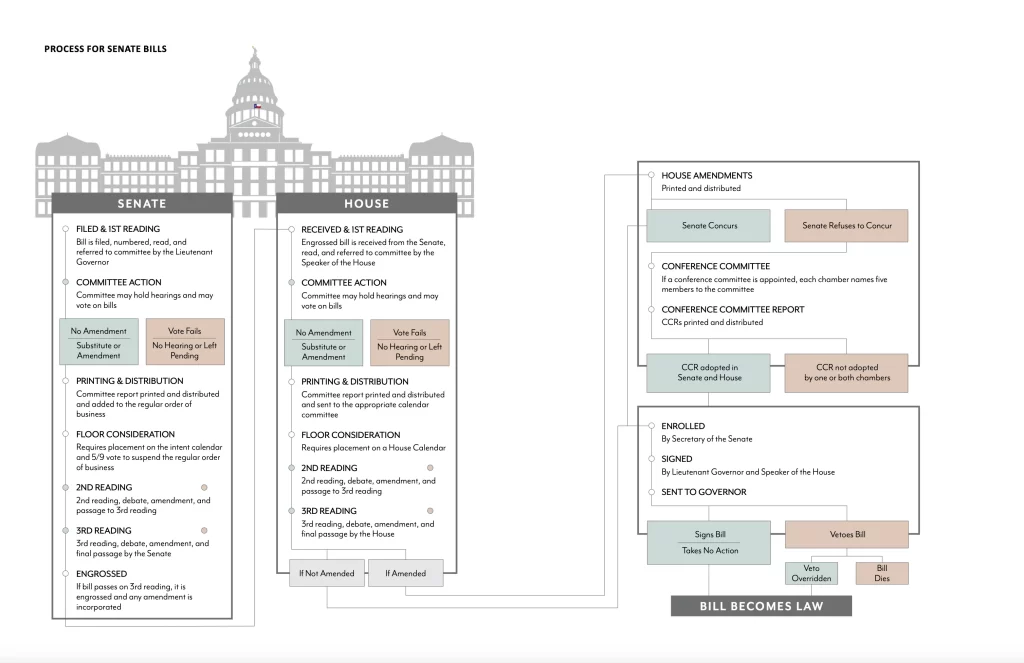
The Texas Senate follows a structured legislative process to introduce, debate, and pass bills. Below is a step-by-step guide to how a bill moves through the Senate:
Bill Filing and Referral
To introduce a bill, or proposed law, a senator files it with the secretary of the senate. The bill is then read into the record (using its title) and referred to a standing committee by the lieutenant governor.
Committee Consideration
After a bill is referred, the senate committee may hold public hearings on it, allowing citizens, experts, and interest groups to provide input. Senators debate the bill, propose amendments, and vote whether to send it to the full senate.
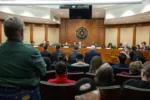
Sometimes committees ignore the bills that are referred to them. Other times, they consider a bill but decide not to report it favorably to the full chamber. If this happens, the bill is considered to have “died” in committee.
Placement on Floor Calendar
Once out of committee, the bill is placed on the senate’s Regular Order of Business, which is a list of all bills and resolutions that have been reported favorably from committees.

Senate rules require bills to be considered on the floor in the order in which they were reported from committee, but in practice the senate considers bills out of order by placing them on a priority list called the Intent Calendar.
Approval of five-ninths of the members is required to place a bill on the Intent Calendar and thereby clear it for floor consideration.
Senate Floor Consideration
On a given day, the senate may take up any bill on its Intent Calendar. The bill caption is read, a step known as Second Reading, and then the bill is subject to debate and amendment. A bill may be amended on second reading by a simple majority of those present and voting.
After the bill is debated and amended, the members take a vote, known as a second-reading vote, which is the first of two floor votes required for approval. If approved, the bill is considered passed to third reading.
Final Vote: Third Reading
The chamber then considers the bill again, a step referred to as Third Reading. Amendments at this stage require approval of two-thirds of the members present and voting, according to senate rules. The bill is considered finally passed if approved by a simple majority vote.
Although the Texas Constitution requires a bill to be read on three separate legislative days in each chamber before it can have the force of law, this rule may be suspended by a four-fifths vote of the members present.
In such cases, the bill is given an immediate third reading following its passage from second reading. The senate routinely suspends the constitutional provision in order to give a bill an immediate third reading.
Referral to the House
After a bill passes on third reading, legislative staff prepare a final text of the bill that incorporates all the approved corrections and amendments, a process known as “engrossment.” A copy is then sent to the Texas House of Representatives for consideration.

The House must pass the bill in the same form in order for it to become law. If it makes amendments, then the bill will not become law unless the senate takes another vote assenting to the House amendments.
Once the two chambers have ironed out differences between versions of the same bill and taken final votes of approval on any amendments, as necessary, the bill is signed by the presiging officers in their respective chambers, at which point it it is considered “enrolled.”
An enrolled bill will become law on its effective date, unless vetoed by the governor.
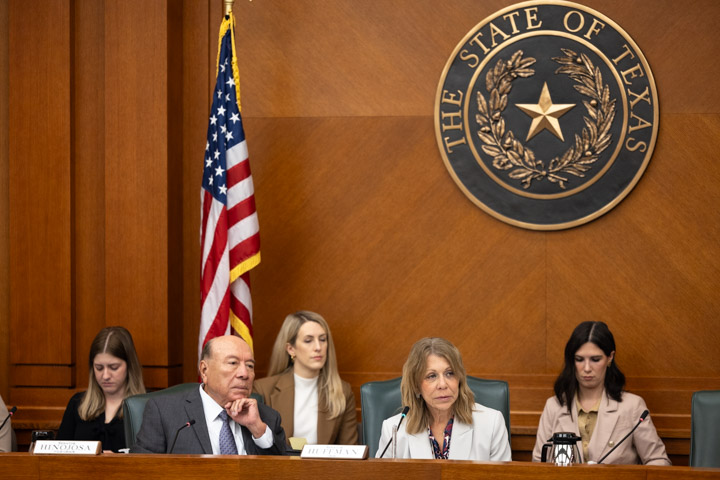
Senate and House committees carry out much of the routine work of the Texas Legislature, debating bills, tweaking and revising bills before they reach the floor, and holding public hearings to allow the public to give input on legislative proposals.
Committees also carry out an oversight role by summoning executive branch officials, conducting studies and hearings on different topics during the interim between legislative sessions, and issuing subpoenas for information, as needed.
The Texas Senate has the following standing committees:
- Administration
- Border Security
- Business & Commerce
- Criminal Justice
- Economic Development
- Education
- Finance
- Health & Human Services
- Higher Education
- Jurisprudence
- Local Government
- Natural Resources
- Nominations
- State Affairs
- Transportation
- Veteran Affairs
- Water, Agriculture & Rural Affairs
Additionally, the lieutenant governor may establish temporary committees, which are called “interim” or “select” committees, or a “joint” committee with the House of Representatives.
During the 87th legislative session (2021), the senate created a special committee on redistricting and a special committee on constitutional issues, which dealt with a proposal for to allow the permitless carry of handguns, also called constitutional carry. In the previous biennium (2019-2020), the senate also had a select committee on mass violence prevention, which was created as a response to mass shootings in El Paso, Santa Fe, and elsewhere.
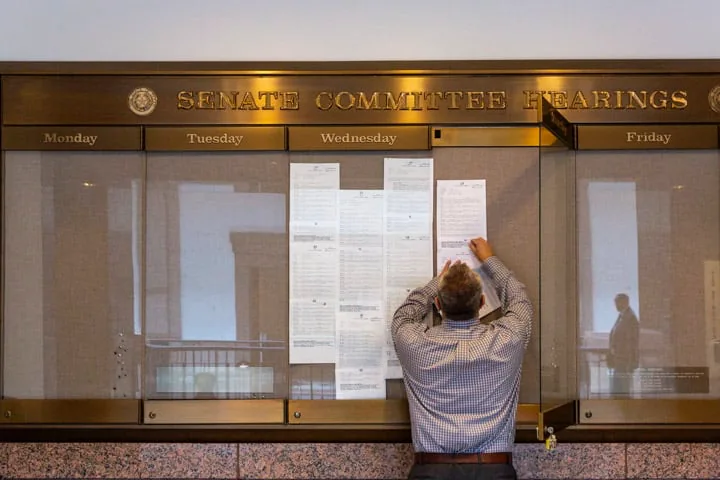
The Senate relies on a a number of internal administrative and support organs, such as the Senate Research Center, as well as five external support agencies. These five agencies are:
The Texas Senate consists of 31 districts, each representing approximately 800,000 residents. Every 10 years, the legislature redraws district boundaries based on U.S. Census data, a process known as redistricting.
